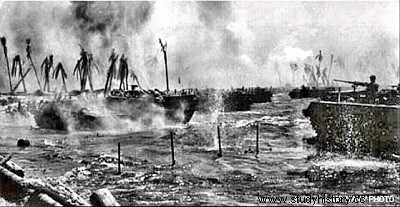
After gathering his troops and rehearsing at Vaté aux Nouvelles- Hebrides, Admiral Hill set course for his objective. Hundreds of miles away, Admiral Turner was heading for Makin. One hundred miles separate the two atolls and the two attacking forces followed two roughly parallel routes.
In Makin Atoll, Sub-Lieutenant Ishikawa had about 800 men, only part was made up of marines, the others belonging to the maintenance or construction teams. These troops were installed on the island of Butaritari, which Admiral Turner was to attack; they benefited from strong entrenched positions, pillboxes, anti-tank ditches and a trio of 80 guns. Most of these assets were concentrated in a belt that stretched in the center of the small island all the way. General Smith, commanding the landing troops at Makin, had prepared the following plan:two battalions were to set foot on the western end of Butaritari, set up a bridgehead, then advance towards the Japanese positions. About two hours after this action, a third battalion of the 165th was to enter the lagoon and directly attack the enemy strongpoint.
With the support of an aircraft carrier and a deluge of projectiles from the support ships, the landing was carried out more or less according to the program planned for November 20. Fortunately, the Japanese did not oppose the attack coming from the side of the ocean:without LVT, the men had to wade through the coral reef in the middle of "pots" and viscous pebbles. On the side of the lagoon, it was a different matter:the men, having barely arrived on land, immediately found themselves right in the middle of the Japanese works and so close to the enemy that no support from planes or ships could have provided them. be of some help. The two landing parties failed to link up that day; but they were firmly established on the island.
On November 21, teams of infantry and tanks and engineers equipped with flamethrowers and demolition equipment began the destruction of the Japanese installations which had resisted them the day before. By nightfall General Smith's men had accomplished most of their mission, and on the 22nd a battalion set out to search for the last defenders and bring them out of hiding. After a very hard fight to cross a line of trenches and works hidden by thick vegetation and a night spent repelling incessant counter-attacks led by small groups, the way was clear to move on to the final cleaning. On November 23, at 11.30 a.m., General Smith sent this message to Admiral Turner:“Makin is taken. »
The regiment had 66 killed and 152 wounded for its baptism of fire. On the Japanese side, only one survivor was captured, a sailor, as well as 104 Korean workers. All the rest of the garrison had been killed at their post.
It was, in fact, the fleet that suffered the greatest casualties of the battle. On the 24th, the Japanese submarine I-175 torpedoed the escort carrier Liscombe Bay. Her aircraft bombs exploded and she sank within 23 minutes, taking with her 644 officers and sailors. Off Tarawa, on the night of
20 November, the aircraft carrier Independence had more luck; Hit by a torpedo launched by a Japanese bomber coming from Roi (in the Marshalls), the large building was still able to return to its base.
On Abemama, it was almost without firing a shot that the landing took place on
21 November. The Nautilus submarine had dropped off the company of marines who had very easily captured the barely defended atoll. Most of the 22-man garrison killed themselves, after the fire from the 127 guns of the submarine and the supporting destroyers. This easy victory contrasted strangely with the losses suffered by the Americans at Makin and especially in the terrible affair of Tarawa.
The 1st Div. Para ended 1943 in the Adriatic sector, on the front of the Sangro River where it had withdrawn from Apulia before the advance of Montgomerys 8th Army. During the retreat, the paratroopers, applying the principle that a heap of rubble provides good cover for the defender while complica
